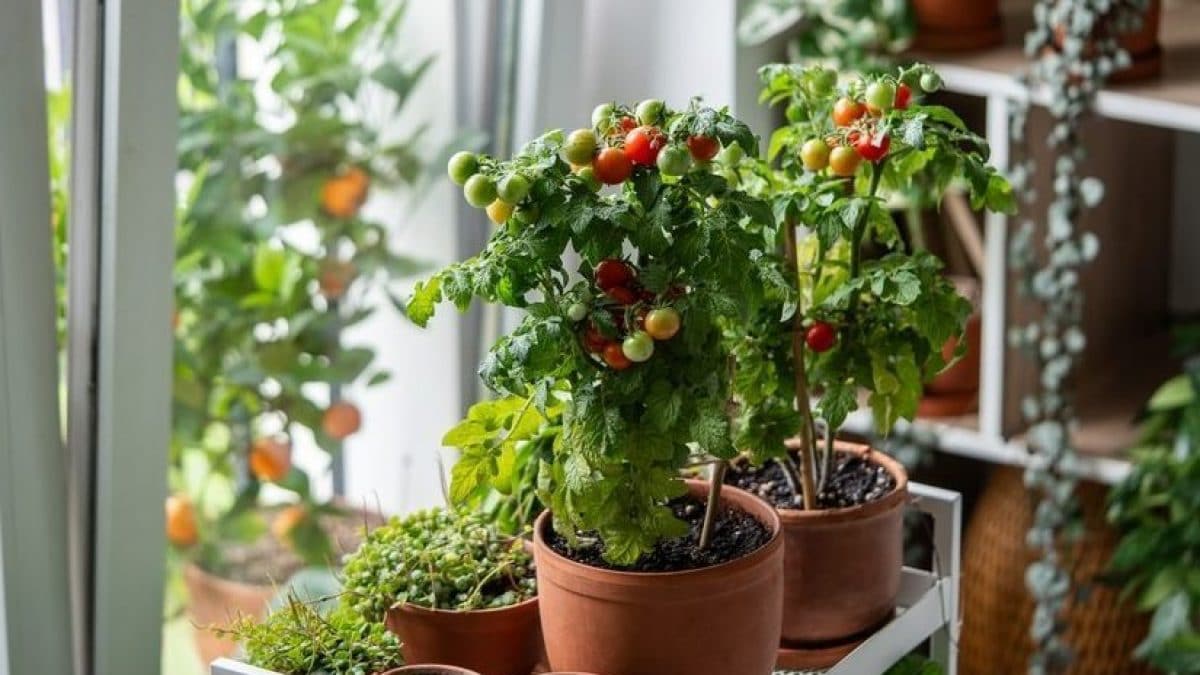
For those who love DIY gardening, but live in the city, growing tomatoes in pots can be a great satisfaction. The reason? You don't need a lot of space, just a sunny terrace or balcony to get lush plants and juicy, fragrant tomatoes, perfect for enriching your recipes. A versatile vegetable that everyone tends to like: having it always on hand is a great advantage, with the addition that you know exactly how it has been "taken care of". Tomatoes have specific needs and to have a generous harvest, a little care is needed: here's everything you need to know before getting to work.
Which Tomatoes Can Be Grown in Pots?
Let's start from the beginning: there are many varieties of tomatoes, which are divided into two macro categories, salad and sauce, with different shapes, sizes, colors and flavors. In addition to the intended use and your personal tastes, however, it is important to know that the types are also divided based on their growth method: determinate and indeterminate. The former are plants of small dimensions, some also called " dwarf ", which naturally stop at a pre-established height, with production concentrated in a short period of time; the latter grow in height for the entire duration of the growing season, flowering and fruiting continuously. We can say that those with determinate growth are easier to manage, they do not require large areas to be placed or frequent pruning or excessively high supports, while tomatoes with indeterminate growth are better suited to a real vegetable garden. Without a doubt, the preferred varieties are those which are "small" in every sense, such as cherry and datterini tomatoes: round or slightly elongated, of different colours (red, yellow and black, like the black cherry), they resist blossom end rot – the formation of a black part at the end of the fruit – better than the larger ones such as the San Marzano or the beefsteak tomatoes and aesthetically they are very pretty, also functional in a decorative way.
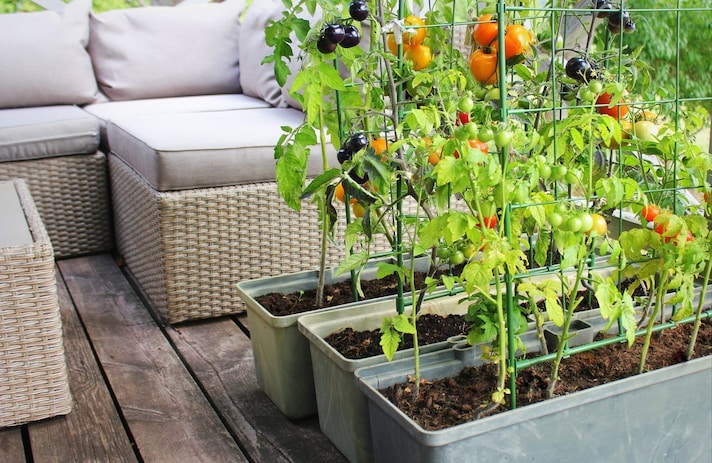
How to Grow Them: Some Tips
In addition to the more classic and evergreen aromatic herbs, such as basil, mint, parsley and rosemary, seeing tomatoes on balconies and terraces is increasingly common. This is because it is a much-loved and used vegetable, which when bought at the supermarket often disappoints: growing it in a pot can be a good solution, but remember that it is a plant that requires attention. Below, some practical advice, to help you find your way more easily even if you are a beginner.
Calculate Your Times Well
If your idea is to start from seeds, tomatoes are sown between late winter and early spring, depending on the climate zone: the operation must be done in a sheltered place, in a seedbed or in pots to be kept indoors or in a greenhouse, because these vegetables need a minimum temperature to germinate, which does not fall below 55°F/13°C. The seedlings are left to grow until they have at least 4-6 leaves and are about 10-15 cm tall. At that point they can be transplanted into pots outdoors, from late April onwards, when the risk of frost has passed. If you prefer to avoid sowing, you can buy ready-made seedlings in nurseries starting in May, with ripening beginning in June.
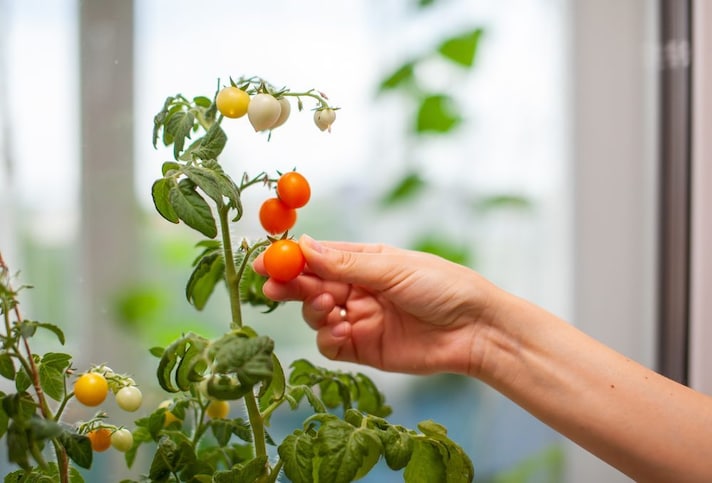
Choose the Right Vase
The container must be quite large. Depending on the variety, choose a pot between 25-35 cm in diameter and the same depth. Tomatoes have roots that develop downwards, making it necessary to have a large support in which stagnation does not form.
Use a Rich, Well-Draining Soil
From this point of view, tomatoes are demanding, because they must find fertile soil right from the start: a universal soil alone is not enough: a mix composed of vegetable soil, sand and expanded clay is better.
Put Plants in The Sun
Another fundamental factor: plants need heat. Choose a spot on the balcony facing south or south-east, where it can receive at least 6-8 hours of direct sunlight every day. If the light is scarce, the plant will grow stunted and will bear few fruits; if instead it is too strong, in the central hours of the day, you can cover the plants with a specific transparent sheet, which protects them from UV rays.
Water Regularly, But Don't Overdo It
The rule is simple: the soil must remain moist, not soaked. In spring, watering every two or three days is enough, but in summer it may be necessary to intervene every day depending on the temperature: feel with your finger to understand the situation. Compared to the traditional garden, in fact, the soil in a pot dries out more quickly. Avoid wetting the leaves, but act at the base of the plant.
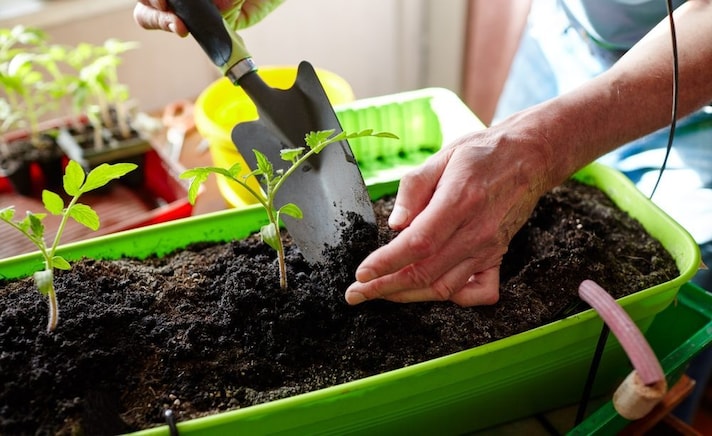
Fertilize Every 10-15 Days
Fertilizing the plant means providing the right energy. Generally speaking, although it depends on the specific case, add specific liquid fertilizer for tomatoes to the pot every 10-15 days, in certain situations it can also be useful once a week. There are several on sale, but what matters is that it is rich in potassium, magnesium and calcium: in particular, a deficiency of the latter leads to the apical rot mentioned above.
Retain Moisture
A ground cover helps retain moisture and reduces plant stress: in jargon, this is called mulching – with straw, dry leaves or coconut fibre – which also prevents the formation of surface crusts and keeps weeds away, even if they are rare in pots, while they are more widespread in the field.
Use Braces and Supports
Even though we are talking about rather compact types of tomato plants, they can exceed a meter in height and this is why it is always advisable to support them with supports, to prevent them from bending under the weight of the fruit. It is useful to insert a support right from the start, to direct growth: you can opt for a cane, a trellis, or stakes that form a kind of cages and nets. Tie the plant delicately, using raffia or soft string. To give stability, you can also proceed with earthing, accumulating soil around the base of the stem, so as to also protect the superficial roots.
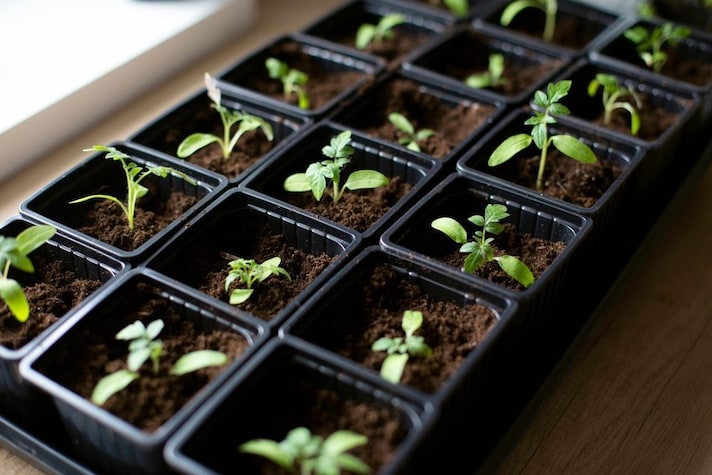
Proceed With Pruning
Pruning is an important operation to optimize production and keep plants healthy. It mainly consists of “de -sprouting”, or the elimination of axillary shoots that grow between the main trunk and the lateral branches. Another practice is topping, which consists of cutting the apex of the plant to limit the height and encourage the ripening of the fruits already present.
Check the Health of The Plant
As we have seen, tomatoes need to be looked after: we suggest you monitor them as much as possible, paying attention to the appearance of anomalies, such as yellowed, stained or curled leaves, blackened fruits, the presence of insects such as aphids and midges or softness of the stem: these are signs of suffering caused by poor exposure, errors in irrigation (too much or too little water) and lack of nutrients and symptoms of fungal diseases.
;Resize,width=767;)
